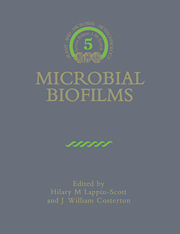Book contents
- Frontmatter
- Contents
- List of Contributors
- Series Preface
- Introduction to Microbial Biofilms
- Part I Structure, Physiology and Ecology of Biofilms
- 1 Growth of Microorganisms on Surfaces
- 2 Dynamics of Bacterial Biofilm Formation
- 3 Cultivation and Study of Biofilm Communities
- 4 Genetic Responses of Bacteria at Surfaces
- 5 Biochemical Reactions and the Establishment of Gradients within Biofilms
- 6 Mechanisms of the Protection of Bacterial Biofilms from Antimicrobial Agents
- Part II Biofilms and Inert Surfaces
- Part III Biofilms on the Surfaces of Living Cells
- Index
1 - Growth of Microorganisms on Surfaces
Published online by Cambridge University Press: 24 November 2009
- Frontmatter
- Contents
- List of Contributors
- Series Preface
- Introduction to Microbial Biofilms
- Part I Structure, Physiology and Ecology of Biofilms
- 1 Growth of Microorganisms on Surfaces
- 2 Dynamics of Bacterial Biofilm Formation
- 3 Cultivation and Study of Biofilm Communities
- 4 Genetic Responses of Bacteria at Surfaces
- 5 Biochemical Reactions and the Establishment of Gradients within Biofilms
- 6 Mechanisms of the Protection of Bacterial Biofilms from Antimicrobial Agents
- Part II Biofilms and Inert Surfaces
- Part III Biofilms on the Surfaces of Living Cells
- Index
Summary
Introduction
Traditional microbiological investigations have focused on the culture and analysis of pure cell lines of bacteria, in either batch or chemostat culture. However, it has been clearly established that in nature, disease and industry, the majority of bacteria exist attached to surfaces within biofilms (Costerton et al. 1978, 1987; Lappin-Scott & Costerton 1989; Characklis et al. 1990a). Furthermore, it has also been established that the bacteria which exist in biofilms, termed sessile bacteria, are inherently different from bacteria existing in the planktonic state. In the sessile state, bacteria may express different genes, alter their morphologies, grow at different rates, or produce extracellular polymers in large amounts (Costerton et al. 1978; Wright et al. 1988; Gilbert et al. 1990; Dagostino et al. 1991; McCarter et al. 1992). One significant consequence of sessile growth is that biofilm bacteria are more resistant to medical and industrial control strategies than their planktonic counterparts (Brown et al. 1988; Nichols 1989; Eng et al. 1991; Blenkinsopp et al. 1992).
The development of complex attached and aggregated communities is also important for the survival and reproductive success of microorganisms. These communities have been considered to act as reservoirs for diverse species, sites of specific limited niches, and protective refuges from competition, predation or harsh environmental conditions, allowing otherwise poor competitors to survive. Integration into a biofilm or bioaggregate may be regarded as a survival strategy beyond that of maximizing or increasing the growth rate.
- Type
- Chapter
- Information
- Microbial Biofilms , pp. 15 - 45Publisher: Cambridge University PressPrint publication year: 1995
- 33
- Cited by

